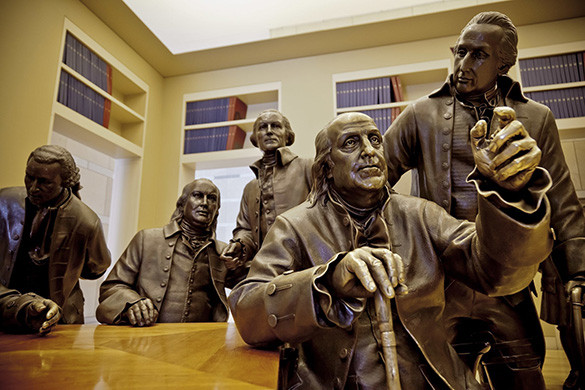About the Signers

The delegates who signed the Declaration of Independence and the Constitution met in the same building about 11 years apart in Philadelphia.
In all, 56 delegates signed the Declaration of Independence on various dates after the Continental Congress approved it on July 4, 1776. Many members signed an engrossed version on August 2, 1776, in Philadelphia. Richard Henry Lee, George Wythe, Elbridge Gerry, Oliver Wolcott, Lewis Morris, Thomas McKean, and Matthew Thornton signed the document after August 2, 1776, as well as seven new members of Congress added after July 4. Seven other members of the July 4 meeting never signed the document. Thomas McKean was the last delegate to sign, in January 1777.
The signing of the Constitution happened under different circumstances on September 17, 1787. During four months of deliberations, the delegates drew up a plan for a new form of government that would replace the one established by the Articles of Confederation.
George Washington presided over the Convention, which featured many of the most important regions leaders in the country, as well some of the nation’s leading political figures and thinkers, including George Washington, Benjamin Franklin, James Madison, James Wilson, Gouverneur Morris, and Alexander Hamilton. Absent were Thomas Jefferson, John Adams, and John Hancock.
On September 17, 1787, the group met to conclude its business in Philadelphia. Wilson read a speech written by Franklin to the delegates with a plea for all of them to sign the Constitution. “I cannot help expressing a wish that every member of the Convention who may still have objections to it, would with me, on this occasion doubt a little of his own infallibility--and to make manifest our unanimity, put his name to this instrument,” Franklin wrote.
Elbridge Gerry, George Mason, and Edmund Randolph objected to the final version of the Constitution. The three dissenters spoke during the debate and explained why they wouldn’t sign the final document. Gouverneur Morris and Hamilton argued that the delegates needed to sign the Constitution. Franklin then made the final motion to sign the document, which was approved by 10 of the state delegations.
Of the 41 men in the room, 38 signed the document, with George Read also signing for an absent John Dickinson. William Jackson, the group’s secretary, signed to attest to the Constitution’s authenticity.
Six delegates had signed both the Declaration and the Constitution: George Clymer, Benjamin Franklin, Robert Morris, George Read, Roger Sherman, and James Wilson.
More on the Declaration
Learn more about the delegates who signed the Declaration, its impact across history, and exciting new content and events related to its 250th anniversary.

The Declaration Across History
Read excerpts from historic documents, curated by scholars, that draw on the push for a range of visions for America.

Signers of the Declaration
Historian Carol Berkin shares definitive short biographies of the 56 men who signed the Declaration. This section also includes an engaging video for each signer.

America at 250 Civic Toolkit
The toolkit brings to life the Declaration, the Constitution, and enduring principles that define America. It features America at 250 multimedia content, events, and continuously updated resources.




